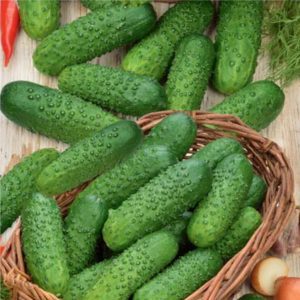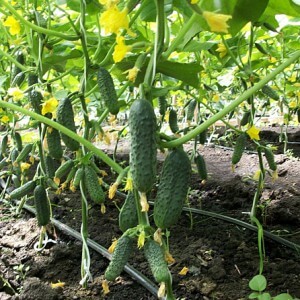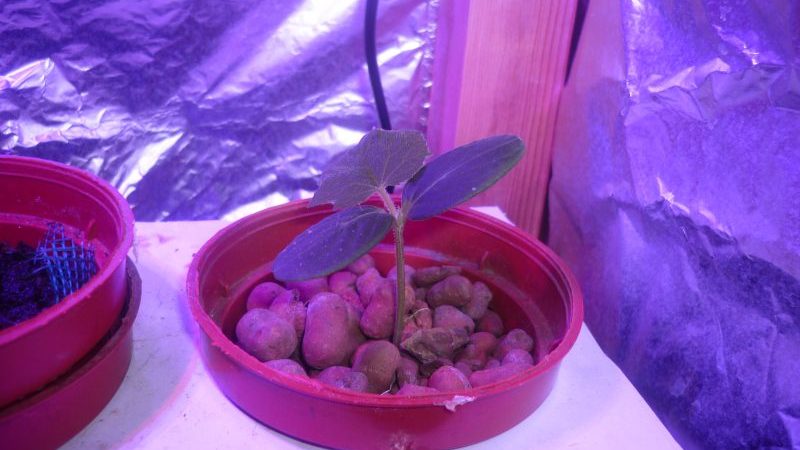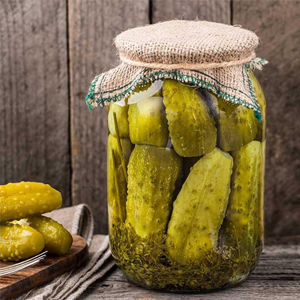How to properly grow Marinda f1 cucumbers on your plot and get a rich harvest
Marinda F1 is an honorable veteran among cucumber hybrids. It has been in demand among Russian gardeners for more than 25 years, since it does not cause problems during cultivation, pleases with an excellent harvest and strong immunity to major crop diseases.
The content of the article
Description of the hybrid
Marinda is an early ripe hybrid of cucumbers created by the Dutch company Monsanto at the end of the 20th century.... The crop is intended for cultivation in open and closed ground, suitable for planting in the Central and Central Black Earth regions of Russia.
The plant has a female flowering type, weakly branches, does not need pollination. The leaves are heart-shaped, medium-sized, colored light green. The main stems are creeping vines. They end with antennae, with which the bushes cling to the supports.
The culture is distinguished by a bundle type of ovaries: 5–8 fruits are formed on one node.
Cucumbers are gherkin type, cylindrical in shape with miniature seed chambers. Covered with a dark green bumpy skin with white thorns.
Reference! The hybrid was included in the State Register of Seeds of the Russian Federation in 1994.
Distinctive features
Marinda f1 differs from other varieties of cucumbers:
- high yield;
- the ability to form pollen-free fruits;
- excellent commercial qualities of the crop;
- congenital resistance to disease;
- short growing season;
- high content of iodine, potassium and fiber in fruits.
Composition and properties
The hybrid fruit has a rich chemical composition, including:
- fiber;
- organic acids;
- vitamins E, C, K, PP;
- beta carotene;
- B vitamins (pyridoxine, biotin, thiamine, choline, pantothenic and folic acids, riboflavin);
- macronutrients (potassium, chlorine, phosphorus, magnesium, calcium, silicon, sulfur, sodium);
- trace elements (selenium, zinc, boron, aluminum, iodine, fluorine, iron, chromium, manganese).
Nutritional value of cucumbers per 100 g:
- calorie content - 13 kcal;
- proteins - 0.7 g;
- carbohydrates - 2.5 g;
- fat - 0 g.
Benefits of Marinda fruits:
- replenish the water balance;
- eliminate heartburn;
- cleanse the body of toxins, toxins and heavy metal salts;
- normalize digestive processes;
- prevent the deposition of adipose tissue;
- lower cholesterol levels;
- normalize blood pressure;
- relieve gum inflammation;
- improve the condition of the skin;
- relieve pain in gout, arthritis;
- heals the joints;
- reduce the concentration of uric acid;
- regulate kidney function;
- improve memory;
- strengthen the nervous system.
Attention! A few fresh cucumbers can help relieve your hangover. They will remove toxins and alcohol metabolites from the body.
Specifications
The main characteristics of the hybrid are presented in the table:
| Bushes |
|
| Fruit |
|
| Ripening terms | 40–55 days |
| Yield | 25-30 kg / m2 |
| Suitable growing regions | Central and Central Black Earth |
| Pulp characteristics |
|
| Purpose of fruits | Used:
Used in folk medicine and home cosmetology. |
How to grow yourself
Marinda F1 is intended for outdoor cultivation in the southern regions of the country. In the conditions of the middle zone and northern regions of Russia, it is better to plant the hybrid in greenhouses.
Planting with seeds and seedlings
The culture is planted immediately at their summer cottage or sown in boxes at home for growing seedlings. Although the seeds of the hybrid have a high germination rate, experienced gardeners prepare them for sowing. For this:
- Dissolve 1 tsp in 500 ml of water. salt.
- The planting material is placed in the resulting solution and left for 15–20 minutes.
- The floating seeds are removed: they are not suitable for planting.
- The rest are washed under running water, dried on a paper towel.
- If desired, the seeds are germinated: wrapped in a damp cloth, placed in a warm place and waiting for the sprouts to appear.
In open or greenhouse ground
For growing Marinda, they choose a greenhouse or a plot with good lighting, protected from winds and drafts, and rich in humus.
Planted according to the scheme presented in the table:
| Planting depth | 2 cm | |
| Distance between | in rows | 60 cm |
| plants | 15 cm | |
| Soil temperatures | + 15 ... + 18 ° С | |
| Sowing time | The end of May | |
Seeding Algorithm:
- Dig the soil to the depth of the shovel bayonet with superphosphate (50 g / m2).
- When planting in bulk greenhouse beds, change the soil to a new one. Prepare a soil mixture of peat, turf and garden soil, humus and sawdust (2: 2: 2: 2: 1), add 1 tbsp. ash and 25 g of superphosphate for each bucket of mixture.
- Form holes 2 cm deep at a distance of 15 cm from each other, leave 60 cm between rows in accordance with the planting scheme.
- Pour plenty of warm water over the pits, place seeds in them.
- Cover with soil, cover with a thin layer of peat.
Until 2-3 pairs of true leaves appear at the shoots, all care will consist in watering and careful removal of weeds.
At home for seedlings
For growing seedlings, individual containers are used (for example, plastic or peat cups). Sowing is carried out 4 weeks before picking to a permanent place.
Step-by-step instruction:
- Fill the containers with the nutrient medium, as with direct sowing on the site.
- Moisten the soil abundantly, make holes in it 2 cm deep.
- Place seeds in them, sprinkle with earth.
- Move the containers to a warm place, cover them with cut plastic bottles, cling film or plastic bags.
- Remove an impromptu greenhouse after germination.
- After 4-5 weeks, transplant the bushes to a permanent place according to the 60x15 cm scheme.
Important! Remember to regularly moisten the soil with a spray bottle or watering can with a fine diffuser so as not to blur the plantings.
Step-by-step cultivation and care
Hybrid Marinda F1 is unpretentious, caring for it consists of standard procedures:
- The bushes are watered once a day, in the evening, with warm water. The soil should be moist, but not without excess liquid.
- Lines are formed into 1 stem: for this, excess lateral shoots and foliage are removed. If the bushes are actively growing, then after they reach 2 m of the top pinch.
- Feed cucumbers with organic and mineral fertilizers. For the first time 2 weeks after picking seedlings into the ground or 1.5 months after sowing on the site.
- After watering, the soil is loosened between the rows, weeds are removed every 10 days. When mulching the beds, the frequency of these procedures is reduced.
Features of cultivation and possible difficulties
Possible problems when cultivating a hybrid:
- If the seedlings of cucumbers are strongly stretched, then it does not have enough sunlight. In this case, the containers with bushes are rearranged to a lighter place or phytolamps are installed.

- If the cucumbers have an irregular shape and are strongly deformed, the plants are fed with nitrogen fertilizers.
- The absence of ovaries is caused by the high air temperature, usually in the greenhouse. To prevent the problem, the bushes are watered with cool water, the door is often left open for ventilation.
- The sheets are covered with small holes as a result of direct sunlight. Landings in this case are shaded: they are covered with a translucent light material during the heat.
Diseases and pests
Marinda F1 is endowed with innate immunity:
- to spotted mosaic;
- cladosporium disease;
- olive spot.
The culture is insensitive to pests, but some gardeners spray the bushes with special means for preventive purposes:
- against melons aphids - 10 g of red ground pepper and 200 g of tobacco dust are poured with a bucket of water heated to + 60 ° C. Insist 5 hours and use as directed;
- against slugs - 5% solution of metaldehyde;
- from plant mites - 15 g of colloidal sulfur is dissolved in a bucket of water.
Attention! Do not use chemicals during the ripening period of the crop so that the fruits are harmless to the body.
Harvesting and application of the crop

The first fruits are harvested 50 days after planting. To increase the productivity of the bushes, cucumbers are picked every 3 days. They are carefully cut with a sharp knife or scissors, keeping the stalk.
Delicious and aromatic vegetables are actively used in cooking. They are pickled, salted, added to preparations for the winter, consumed fresh and crumbled into salads.
The fruits of Marinda are used as part of cosmetic and medicinal products: when applied externally, they mattify the skin, moisturize it, whiten and even out the complexion.
Advantages and disadvantages
Hybrid advantages:
- high productivity;
- resistance to adverse climatic conditions;
- immunity to major diseases;
- parthenocarpic type of pollination.
- the formation of bundle ovaries;
- attractive presentation;
- great taste;
- low price of seed;
- the versatility of using ripe cucumbers.
Gardeners love Marinda for the lack of bitterness in the fruits and ease of care. The disadvantages of culture are at least:
- due to a lack of moisture, the fruits grow small;
- the hybrid does not like acidic soils with a high nitrogen content.
Reviews
There are a lot of positive feedback from vegetable growers about the hybrid on the forums:
Irina, Kazan: “I have been choosing a hybrid Marinda F1 for planting for the third year already. Neat and small cucumbers, as in the photo, are great for pickling and pickling, fresh they go well with other vegetables in salads. If you do not notice the cucumber and do not remove it in time, then it will turn into a "barrel" in a short time, but such fruits do not become bitter, so it is easy to find a use for them. "
Igor, Azov: “A good hybrid, not afraid of pests, not sick. Marinda is an excellent culture for a pensioner, as it does not require special care, and work at a summer cottage is quickly exhausting due to age. "
Conclusion
Marinda F1 is a popular hybrid among Russian gardeners, which has proven itself well over 25 years. Its fruiting does not depend on pollination, 5–8 fruits are formed in one node. The culture is unpretentious in care, resistant to major diseases, pest attacks. The collected cucumbers are not bitter, have a sweet juicy taste, and do not contain voids.